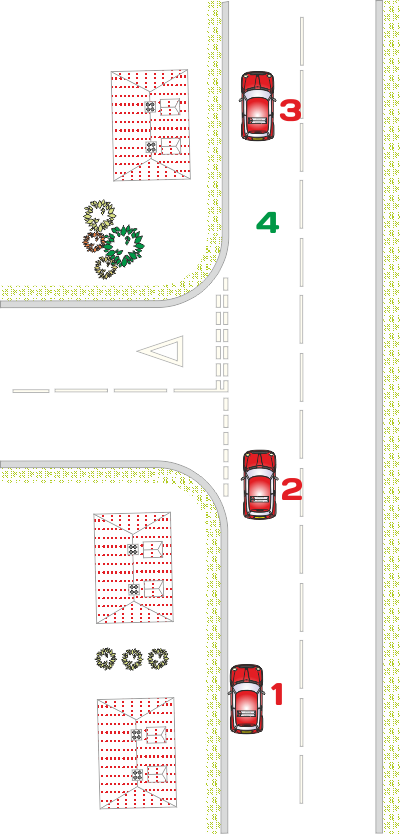With proper observation and accuracy
 Remember, accidents often happen because drivers do not pay attention to the 'basics'. As with all manoeuvres, give way to other vehicles but do not wave them past (see the information in the turn-in-the-road section).
Remember, accidents often happen because drivers do not pay attention to the 'basics'. As with all manoeuvres, give way to other vehicles but do not wave them past (see the information in the turn-in-the-road section).
Position 1:
Make sure that you complete the normal safely checks before moving off.
This might seem obvious, but remember, when you are focusing on the reverse manoeuvre during any kind of driving test it's the obvious things that get missed!
Position 2
Check the target road.
- Is there sufficient space to reverse into?
- Will it be safe to complete the manoeuvre?
- Is it safe - Look for children on the path or other potential dangers.
After making this check begin your MSM routine in order to stop safely at 'Position 3'.
Position 3
The car should stop approximately 18 inches (45cm) from the kerb (getting too close risks tyre damage against the kerb or from debris in the gutter).
Ensure that you make full observational checks to see if the road is clear, especially the right blind spot, before starting to reverse, and that you are looking back (behind the car) before you start to reverse.
Neglecting to make blind spot checks is probably the most common observation fault on the left reverse manoeuvre during ADI Part-Two and other advanced driving tests.
You should be 'reasonably accurate' as you reverse manoeuvre. Reasonable accuracy' means following a steady course within two feet of the kerb at all times.
You can use the nearside mirror to check your position but DO NOT rely on it totally as you might if driving a van. While the mirror is useful for gauging position you get a far better view of the road through the rear screen - simply take quick glances onto the mirror as part of your overall all-around observation.
In terms of car control use the gas pedal as part of your clutch control. Some cars, particularly diesel engine cars, will move without any gas, however with no gas you have less 'fine control'. Also, when working as an instructor you need to be aware that you are teaching 'skills for life' - after your pupils pass they will be driving a range of vehicles, some of which will need gas when manoeuvring to prevent the engine from stalling.
Position 4
Check the road to the front and rear (including the right-hand blind spot) before starting to steer into the side road – the front of the car will swing out. This point is often referred to as the 'point of turn' or 'turning point'.
From this point to the end of the manoeuvre, make frequent checks all around as the car moves back – the best way to keep an accurate course is to ensure that you look well back towards (and beyond) your finishing intended point.
Make sure that you continue to take rear observation up to the point at which your car comes to a complete halt.
Next: Move on to step 4 to watch a video demonstration of the manoeuvre.